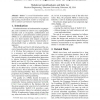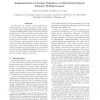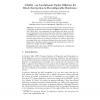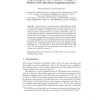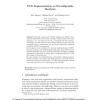TVLSI
2008
14 years 7 months ago
2008
Abstract--This paper presents a new set of techniques for hardware implementations of Secure Hash Algorithm (SHA) hash functions. These techniques consist mostly in operation resch...
SCN
2008
Springer
14 years 7 months ago
2008
Springer
Abstract. The substitution box (S-box) of the Advanced Encryption Standard (AES) is based on the multiplicative inversion s(x) = x-1 in GF(256) and followed by an affine transforma...
CSREASAM
2009
14 years 8 months ago
2009
Tantra 1 is a novel Pseudorandom number generator (PRNG) design that provides a long sequence high quality pseudorandom numbers at very high rate both in software and hardware impl...
HPCA
1995
IEEE
14 years 10 months ago
1995
IEEE
In this paper we consider several hardware implementations of the general-purpose atomic primitives fetch and Φ, compare and swap, load linked, and store conditionalon large-scal...
FDTC
2006
Springer
14 years 11 months ago
2006
Springer
Traditional hardware error detection methods based on linear codes make assumptions about the typical or expected errors and faults and concentrate the detection power towards the ...
FSE
2004
Springer
14 years 11 months ago
2004
Springer
Abstract. We present a fast involutional block cipher optimized for reconfigurable hardware implementations. ICEBERG uses 64-bit text blocks and 128-bit keys. All components are in...
CHES
2006
Springer
14 years 11 months ago
2006
Springer
This article starts with a discussion of three different attacks on masked AES hardware implementations. This discussion leads to the conclusion that glitches in masked circuits po...
CHES
2004
Springer
14 years 11 months ago
2004
Springer
Abstract. Recently, Lenstra and Verheul proposed an efficient cryptosystem called XTR. This system represents elements of F p6 with order dividing p2 -p+1 by their trace over Fp2 ....
CHES
1999
Springer
14 years 11 months ago
1999
Springer
Cryptographic algorithms are more efficiently implemented in custom hardware than in software running on general-purpose processors. However, systems which use hardware implementat...
FPL
2003
Springer
15 years 13 days ago
2003
Springer
Recent developments in information technologies made the secure transmission of digital data a critical design point. Large data flows have to be exchanged securely and involve en...

